This was published 2 years ago
How the Bhutanese beat Sydney’s soaring house prices
This small refugee community is doing things differently to get into one of the toughest housing markets in the world.
By Mridula Amin
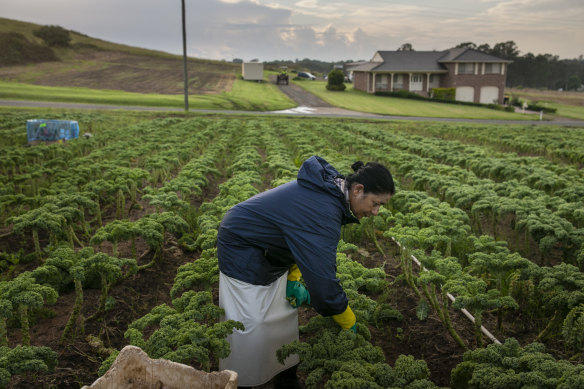
Ranmaya Gotam picks kale at a produce farm in Orchard Hills in Sydney’s west.Credit: Mridula Amin
Ranmaya Gautam is picking kale as the sun breaks first light. Sweat has started to pool near the 54-year-old’s sindoor, a vermilion stroke that powders her hairline, a symbol of marriage in Hinduism.
She and her husband Ram have worked at the same farm in western Sydney for the past decade.
They arrived in Australia as refugees from Bhutan with no money and no English, armed with desires.
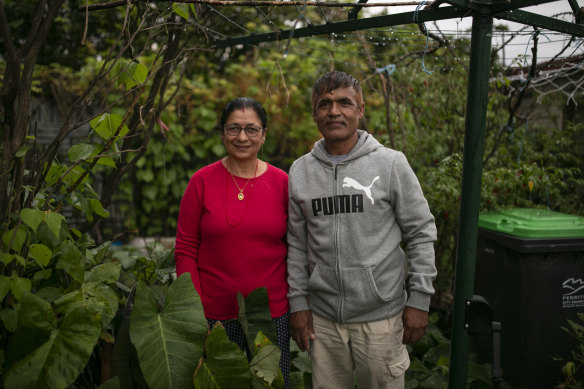
Husband and wife, Ranmaya and Ram Gautam in their backyard garden in South Penrith. They bought the house in 2014.Credit: Mridula Amin
“My first day on the job … my boots got stuck in the muddy field and I couldn’t pull them out. When I stepped, only my legs were coming with me.” Ranmaya laughs.
Two years later, in 2014, their small refugee community did something different to help them buy a home. They sacrificed their own savings to top up Ranmaya and Ram’s to help them reach their dream.
“We had around $70,000 saved after two years working, and about four friends helped us with about 40k,” she says.
Through this highly unusual borrowing custom, the Bhutanese refugee community has managed to beat Sydney’s soaring house prices of recent decades, with 78 per cent of the entire cohort living here now owning their homes, according to the Australian Bhutanese Association. This is 11 per cent higher than the national average.
NSW Premier Dominic Perrottet penned an op-ed last October about how scrapping stamp duty would cut two years from the time it takes people to save for a deposit.
“We can – and we must – harness new ideas to get more people into their own home faster,” he wrote.
Fleeing torture and oppression
But in 1998, Om Dhungel was already thinking outside the box – out of necessity.
Om was one of seven people who made up the entire Bhutanese refugee community in Sydney at the time.
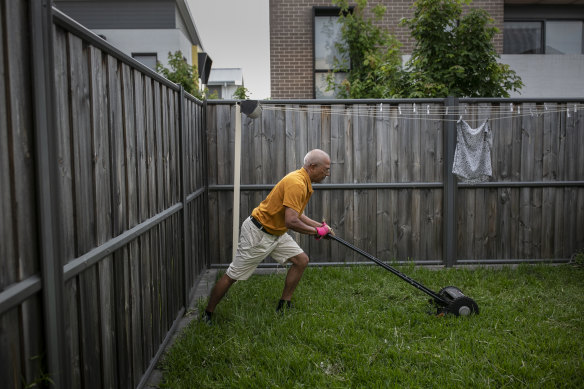
Om Dhungel tackles his back yard at Fairwater, Blacktown.Credit: Mridula Amin
A former high-ranking official in Bhutan’s Telecommunications Department, in Sydney he worked on the assembly line at a phone factory in Penrith.
Born in the remote South Bhutan village of Lamidara, by his late 20s Om was living a sophisticated life as an engineer for the Bhutanese monarchy.
Following the government’s 1989 policy of “One Nation, One People”, Nepalese-heritage Bhutanese such as Om were forced out by ethnic Bhutanese. Torture and imprisonment were common.
After his relatives were tortured and he was warned of his own arrest, Om fled in 1992 with his wife and their two-year-old daughter, leaving their home.
“I found the refugee camps in Nepal, it was just makeshift tarpaulins. At one point 20 people were dying each day due to lack of food and shelter.”
After basing himself in Kathmandu to advocate for international aid, in 1998 he ventured to Sydney to study for an MBA at UTS. He paid his fees from his factory wages and working at Coles.
After 52 rejections for white-collar jobs, someone finally told him he didn’t look trustworthy because he couldn’t look interviewers in the eye. This is a mark of respect in Bhutan.
Soon after, he secured a job with Telstra and his aspirations turned to buying a house. However, as prices kept rising every year, his $60,000 savings weren’t enough.
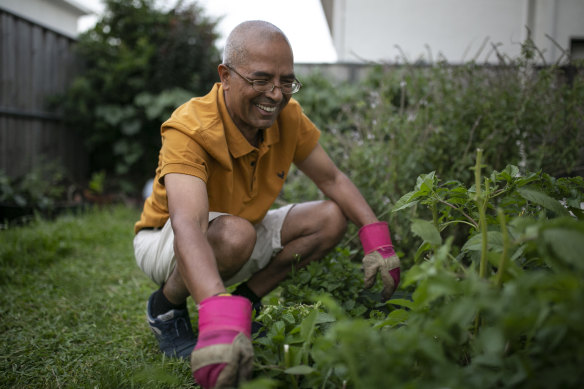
Om Dhungel gardening in his backyard in Blacktown. He is known as being the community leader who encouraged the ideals of Australian homeownership for the Bhutanese refugee community.Credit: Mridula Amin
“I was constantly chasing the deposit, so my friend lent me 20k to buy a house in Blacktown, it was 2004.”
The interest-free gift was repaid by Om within a year, but the gesture remained as a blueprint for the rest of the community.
When Australia accepted 5500 UNHCR Bhutanese refugees in 2008 from a camp in Nepal, Om collected them from the airport alongside service providers.
In between ferrying people to open houses for rentals on the weekends, Om instilled an idea. Buy your own home.
“I perhaps knew that if they got social housing, they wouldn’t leave, and staying on Centrelink wouldn’t be enough to enter the market.
“So we used that carrot every time someone wanted to give up learning English or learning to drive, we’d say, ‘Well, if you want to buy a home you need to do the small steps’.”
‘We could pitch in for a small house’
One of those who heeded the advice was Ram Khatiwada.
Ram and Iswara Khatiwada’s home in Caddens in western Sydney is adorned with lights for Diwali on a rainy evening.
The family holds a platter of candles and offerings, moving from the hallway to the cinema room and upstairs to a small home temple for Hindu deities.
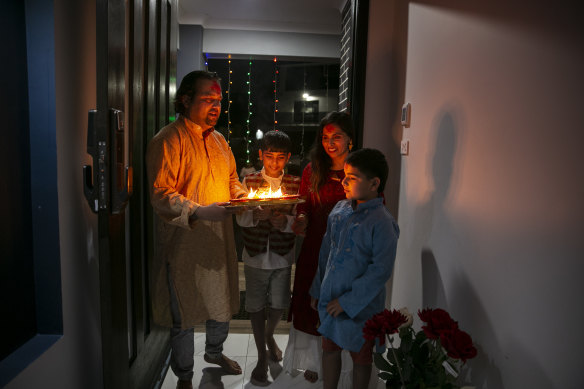
Ram with wife Iswara and their two young sons hold up candles at their doorstep to for Hindu Diwali at their home in Caddens in the Penrith LGA. Credit: Mridula Amin
Ram works as a geriatric nurse at Blacktown Hospital, while Iswara is a disability support worker.
The childhood friends married in the Nepalese refugee camp they lived in for two decades, where it was common for the roofs of their bamboo huts to disappear during storms.
“Each family would hold the pole that held up the roof to avoid being blown away. It still haunts me those memories,” says Ram.
Iswara mentions the beautiful and sturdy two-storey house Ram’s family had just finished building before they fled Bhutan as teenagers.
In 2016, six years after arriving, their extended family of 12 pitched in to help buy the couple’s first house, providing $25,000 for the deposit.
“We had an understanding, we were four brothers, three sisters: whoever has better income, whoever can buy a house, just start doing it. We couldn’t afford a $2 million beach house for everyone even if we all put in, but we could pitch in for a small house. So I went first.”
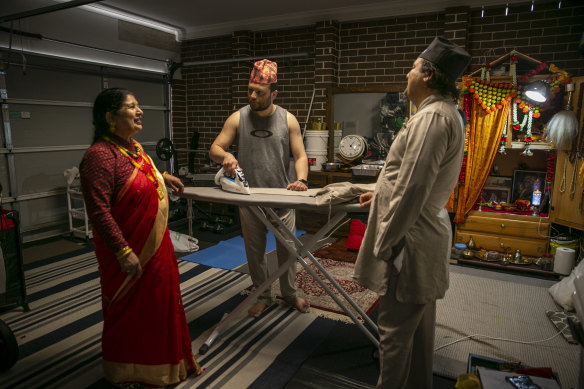
Ram talks to his brother Subash and mother at a celebration for “brother and sister day” at his brothers house in Caddens.Credit: Mridula Amin
The rules were loose but anyone who wasn’t buying a house in the immediate year or two would put a few thousand in. That interest-free loan would be repaid within a year to avoid hurt feelings, so no one would borrow more than they could afford to pay back.
Today, five out of seven of Ram’s siblings have also bought their own homes following the same method, and he’s even lent money to friends.
“When you don’t have much opportunity and very limited resources, you feel sorry for each other in the camp, so you start helping each other, and you see everyone as brother and sisters.”
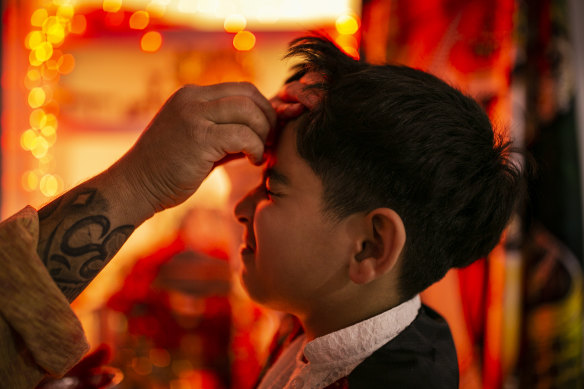
Ram Khatiwada’s eldest son has a tika put on his forehead for Diwali.Credit: Mridula Amin
The 2022 Domain First Home Buyer report listed Sydney as the city with the longest time to save an entry-priced house deposit – at 8 years and 1 month.
For Ram, the ability to enter the market in half the time is due to the guidance of those like Om who settled before him.
“I think if you want to become successful by yourself it’s really hard. To make our willpower strong we rely on our friends and community. When we’re all on same page, the struggle doesn’t feel so lonely. ”
High price to pay
Getting the first stake to enter the housing market doesn’t come without steep sacrifice.
When Manita Nirola talks about what it took, she starts to cry.
“I’m just thinking about how much I went through to get here.”
Priests are gathered in the garage of the house Manita bought with her husband Keshav Nepal, for Graha Shanti Puja, a Hindu ritual to remove negativity and bring wellbeing to the family.
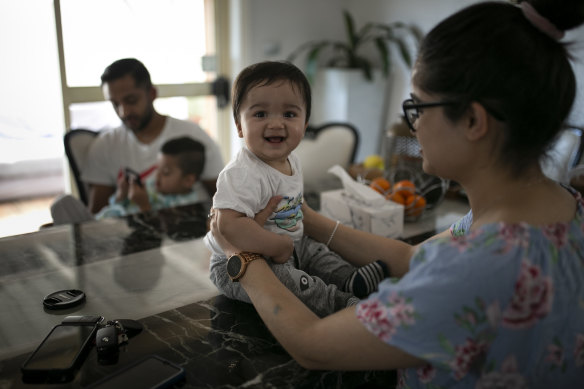
Keshav Nepal, 31, and Manita Nirola (right), 27, hold their children at home at their house in Cambridge Park in Sydney’s west. The lab technician and disability worker are proud home-owners.Credit: Mridula Amin
While Manita didn’t grow up in the camps, Keshav and his family of nine arrived in Sydney on humanitarian visas. When they got married in 2014, she also moved into the family’s bustling rental.
When it came time to live on their own, Keshav took some convincing. Largely because he was in patchy casual jobs with only $200 in the bank, and he was the youngest sibling.
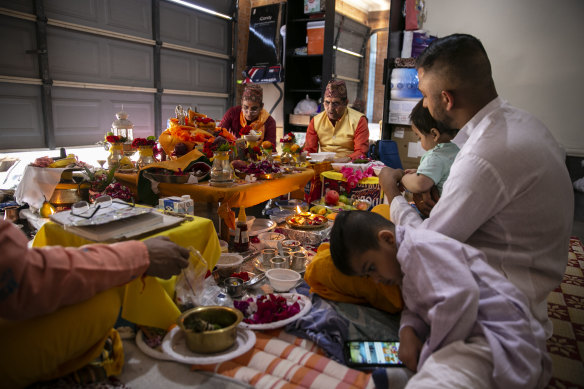
Keshav (in white) and Manita (in red), 27 sitting around a puja ceremony in their garageCredit: Mridula Amin
“Of course, living in a big house was a benefit to us as we don’t have to spend a lot of money,” he says.
“But then in a way coming to Australia I wanted to experience that life being independent, I wanted to experience the struggle I would say.”
With each partner working two jobs in aged care clocking 60 hours a week, time together became scarce.
In two years they saved $100,000 for a house deposit while on salaries that averaged between $22 and $27 an hour.
They covered the deposit for a $625,000 house themselves, with their family pitching in to help furnish it. The next step is building a new house and renting out the first one out as an investment to begin building generational wealth.
Their achievement is not ordinary for their age – only 37 per cent of 25-29 year olds born between 1987-91 owned their homes according to federal government data.
“Not every Bhutanese family does it, but it’s a very common way of helping people achieve their goals,” says Manita.
Migrants helping migrants
When Charlie Xiberras hired Ram and Ranmaya Gautam, they reminded him of his own parents who’d emigrated from Malta.
“I knew from my father that if someone hadn’t given him a go he wouldn’t have made it in Australia, so I had this thing that I wanted to show respect to him and give these people a go too.”
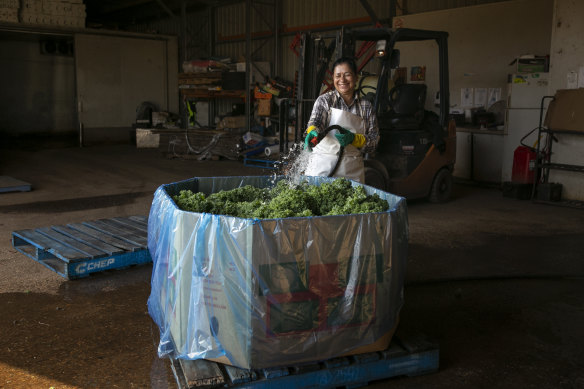
Ranmaya Gautam washes bunches of kale at a produce farm in Orchard Hills.Credit: Mridula Amin
Despite their diligence, Xiberras was still surprised when they managed to save their $16 an hour wages and buy a house after two years.
“I see young Australians that can never own their home and these guys have done it together as a sort of family, it’s very unique.”
While Ram and Ranmaya worked, their four children studied and they used their Centrelink benefits for living costs which helped the parents save the bulk of their earnings.
Before getting their loan, they began calling friends and got assurances from four to meet the shortfall for a $550,000 property in South Penrith.
However, this was 2014, not 2022.
“They do say. ‘lucky we bought back then’, because they probably couldn’t afford it now. That house is probably worth 800k now,” Xiberras says.
In their home in South Penrith, Ram checks on the vegetables he grows, smiling as he holds up each one for inspection.
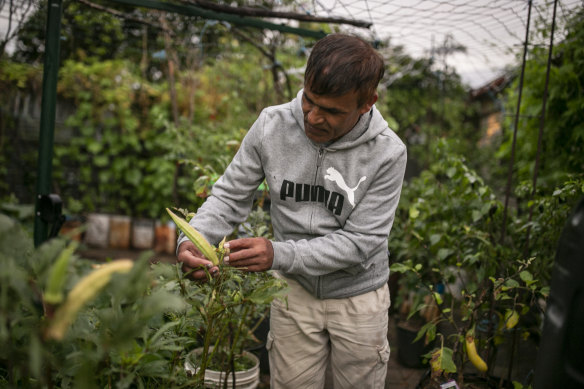
Ram Gautam checks vegetable growth in his backyard garden in South Penrith.Credit: Mridula Amin
A man of few words, he doesn’t like to dwell on the past. He spent six months tortured with rods in jail before he was forced to leave his home.
“I can still remember it clearly but I feel we’re past that part of our lives. I’d love to be called just Bhutanese, not Bhutanese refugees because I do feel free,” he says.
Haven in the west
Western Sydney has become a haven for those who have fled adversity, providing independence and freedom for hundreds of communities – something Om believes other Sydneysiders don’t properly appreciate.
About 98 per cent of Bhutanese refugee families live across Blacktown, Penrith and Campbelltown LGAs, many in new development estates.
“I think we have challenges at the moment, the government contracts a service provider and expects them to have all the answers, but there are certain things they can do, and certain things only a community do,” Om says.
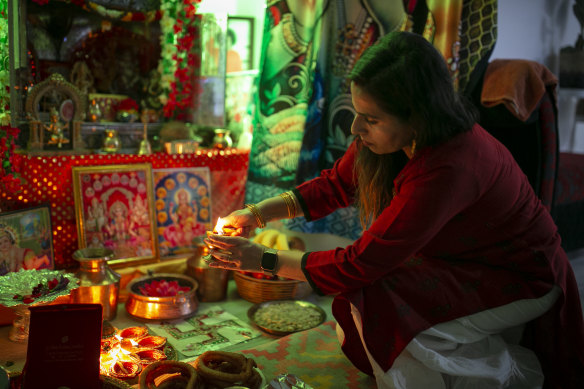
Iswara Khatiwada lights candles near her home for Diwali.Credit: Mridula Amin
“But I suppose the hardest conversation we’ve had as a community is to accept who we are, and not focus on what’s been lost.”
For Om and many like him, owning a home gives them a chance to look ahead and build roots.
“I have properties left behind, my parents they left the trees they grew … but now it’s about the present and creating the future.”
The Morning Edition newsletter is our guide to the day’s most important and interesting stories, analysis and insights. Sign up here.